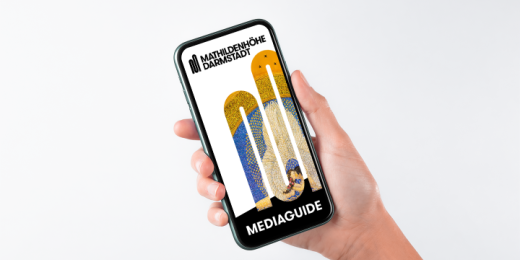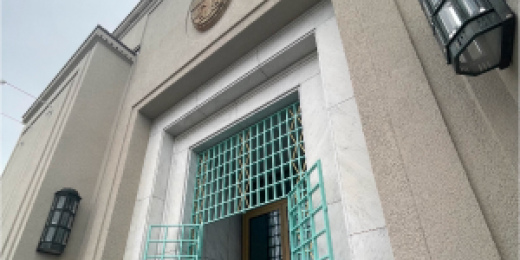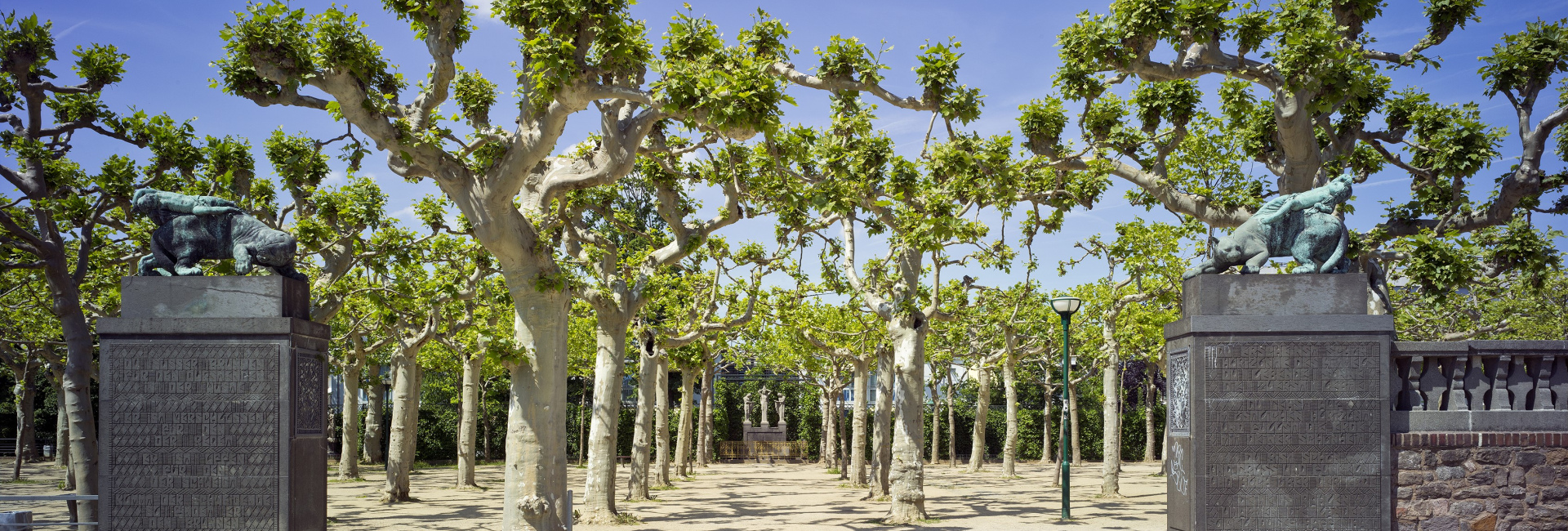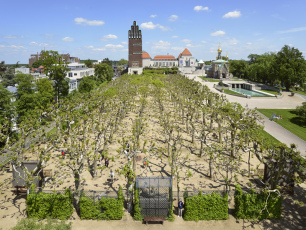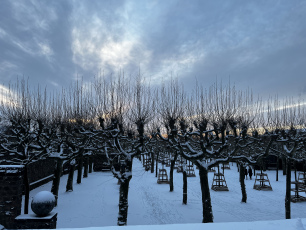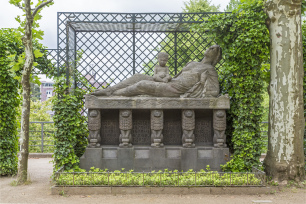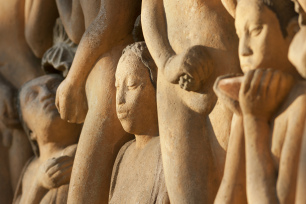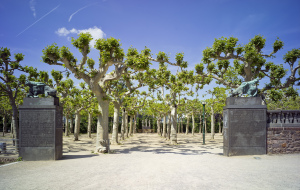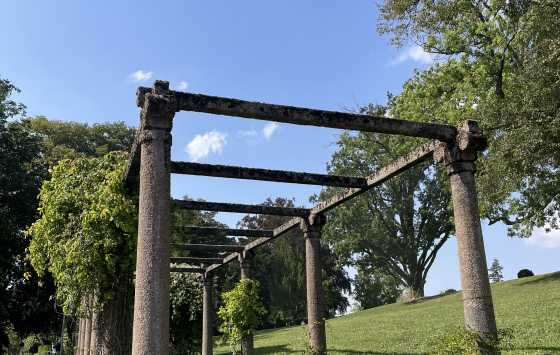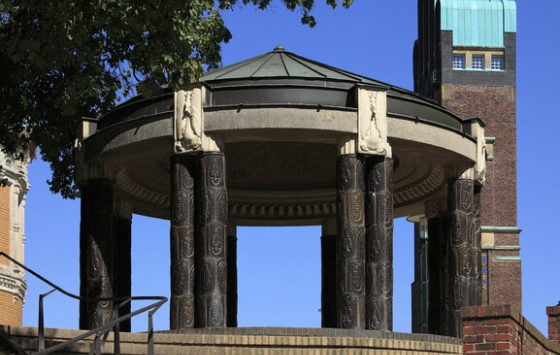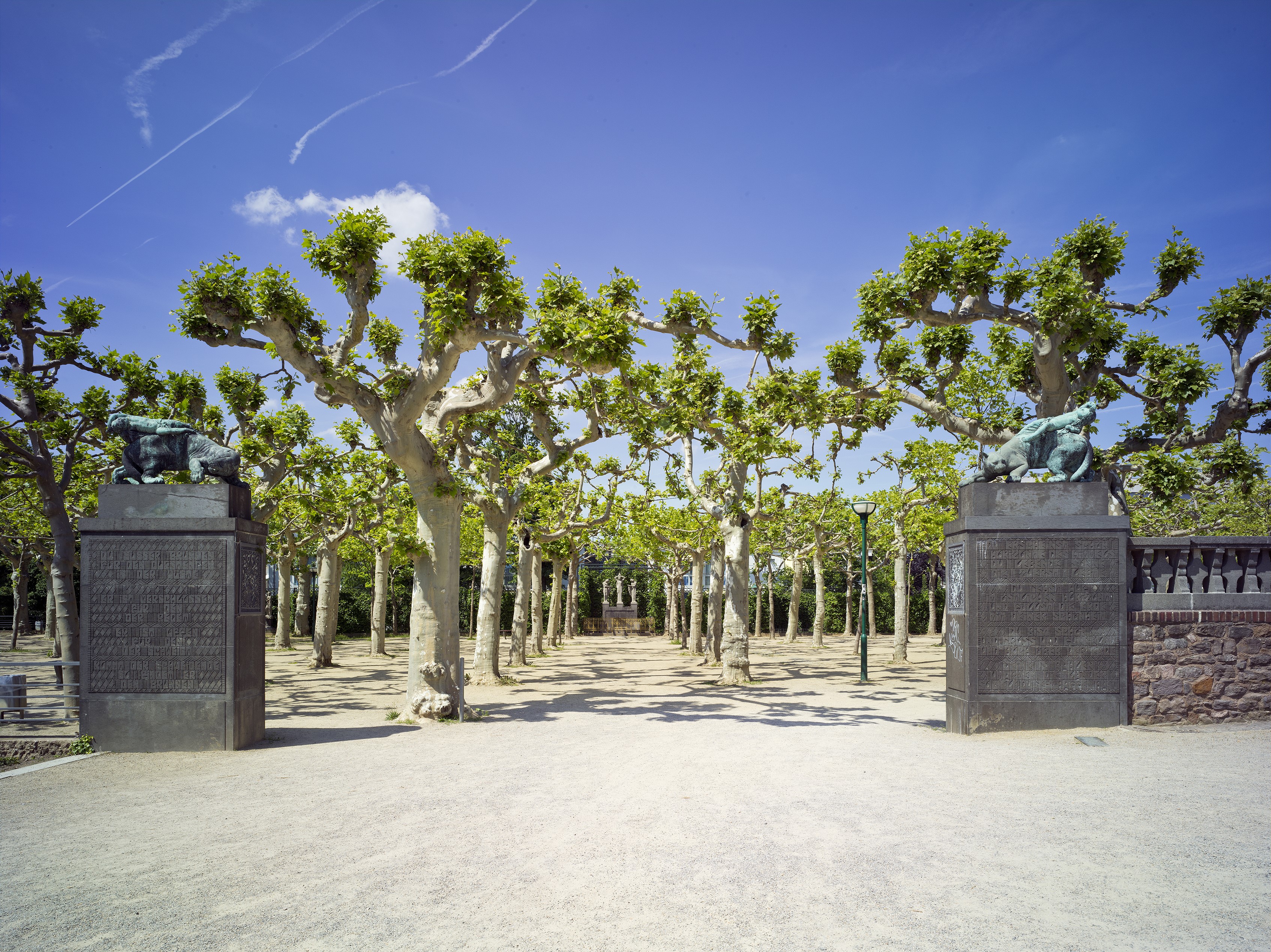
Plane Tree Grove
Architekt: Bernhard Hoetger
Bauphase: 1904 - 1914
The Plane Tree Grove, which was laid out around 1830, has been preserved to this day with its regularly planted and cut trees as part of Mathildenhöhe, which was created by Prince Christian at the beginning of the 19th century. To the east and south, the grove is partly bordered by a retaining wall and to the north and west it is framed by an ivy-covered trellis wall. It is a freely accessible, self-contained space.
Bernhard Hoetger was appointed to the artists' colony in Darmstadt by Grand Duke Ernst Ludwig in 1911 to design this grove artistically for the fourth Mathildenhöhe exhibition of 1914. Hoetger used this commission to develop a total work of art with sculptures, relief walls and inscriptions, in which the theme of becoming and passing away – the cycle of all life – found its artistic expression through the symbol of water.
A total work of art in the plane tree grove
In its extraordinarily original realisation, this ensemble of sculptures has been preserved with all artistic elements. Despite the loss of colour due to weathering, a mythological worldview designed by the artist is still recognisable today. This is an important testimony to the cultural trends at the beginning of the 20th century.
Visitors are invited to embark on a contemplative journey through the ensemble of sculptures. Then a universal world will open up to them that is able to unite immanence and transcendence, archaic forms, ancient Egyptian traditions, and Far Eastern philosophy of religion with the foundations of Christian Western culture.
The portal
On the pillars on both sides of the southern entrance, bronze cats of prey crouch ready to leap, carrying small children on their backs.
Right pillar: mountain lion/puma
Because of its light grey fur, the puma is also called mountain lion. In Chinese mythology, it is associated with the sun and thus also symbolises the day. The beginning of the day is shown here as a child whose young body stretches eastwards towards the rising sun.
Left pillar: panther/leopard
According to tradition, the panther sleeps for three days after each meal and is thus also interpreted as a symbol of death and resurrection. The child on the back of the panther also seems to be sleeping, its body facing the setting sun. The cycle of the sun also corresponds to the cycle of all life.
The inscriptions on the pillars
The bronze sculptures of the portal were complemented by artistically designed inscriptions on the pillar surfaces. In their content they refer to the total work of art of the plane tree grove. A quotation from the Great Sun Hymn of Pharaoh Akhenaton is inscribed on the right-hand pillar, thus taking up the theme of the awakening day.
The inscriptions on the left pillar, taken from an ancient Egyptian manuscript, quote the "fountain prayer" from the papyrus Sallier I. Through the sculptures and inscriptions, both the cycle of the sun with day and night and the element of water are addressed as central themes of the ensemble.
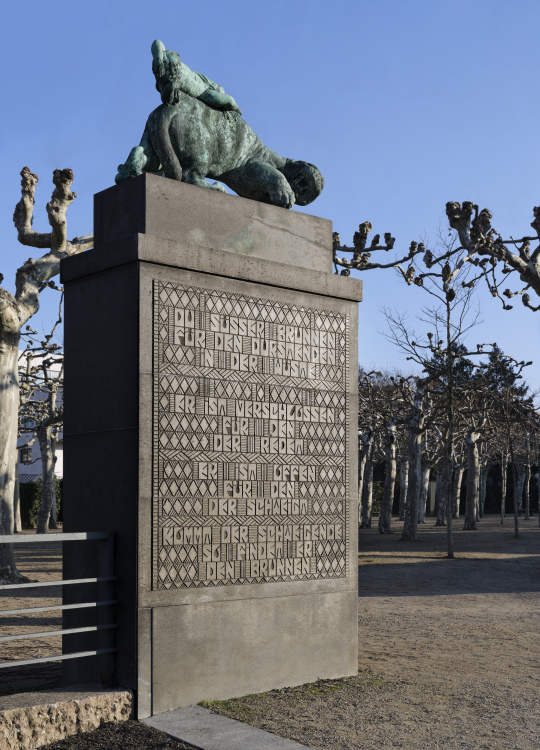
Fountaingroup
From the southern entrance, one looks directly ahead at the architecturally designed fountain group with three female figures carrying water, an artistically crafted fountain wall with water-spouting angel heads, and six guardian lions sitting in rows on both sides. A latticework entwined with ivy forms a protective niche, thus giving the work of art its own special place.
Group of fountains: inscription
The first verse of the poem "Gesang der Geister über dem Wasser" (Song of the Spirits above the Water) by Johann Wolfgang von Goethe is engraved in the pictorially and ornamentally designed wall of the fountain. It tells of the cycle of water from the sky down to earth and up again and is part of the overall theme of becoming and passing as a cycle in nature.
Pitcher bearers
Seven female pitcher bearers placed on either side of the fountain and set in niches symbolically carry the life-giving water into the world. These figures thematically complement the central fountain group on the north side of the grove. As with the other sculptures, the original colouring has not been preserved.
Relief walls: “spring“, “summer“, “sleep“, “resurrection“
To the west and east, between the outer rows of trees two allegorical relief walls face each other. They show the topics of “spring”, “summer”, “sleep” and “resurrection”, central representations of the sculptural programme in the plane tree grove: the cycle of becoming and passing of all life.
The four relief walls have the same compositional structure: six standing figures are lined up alternately with five squatting or kneeling figures. The figures communicate with each other through posture and gesture, some of them seem to be introverted. The contours of the eyes and lips used to be strongly accentuated, which added an expressive aspect to the contemplative ensemble.
From his Parisian life, Hoetger was familiar with the Polynesian type of man that can be found in a painting of Paul Gauguin. This is echoed in the relief figures. In the plane tree grove, the sculptor implemented current impulses of his time in his works in a manner that is both idiosyncratic and convincing.
With these figures of the relief walls, Hoetger found an archaic expressiveness that completely overcame 19th century Impressionism. Taking up Aristide Maillol’s pure line of the body, resulting furthermore in a simplified form, these works fuse Far Eastern physiognomies with the contemplative-looking body language of non-European cultures. The standing and squatting figures radiate a cheerful serenity that seems dreamy and no longer bound by time.
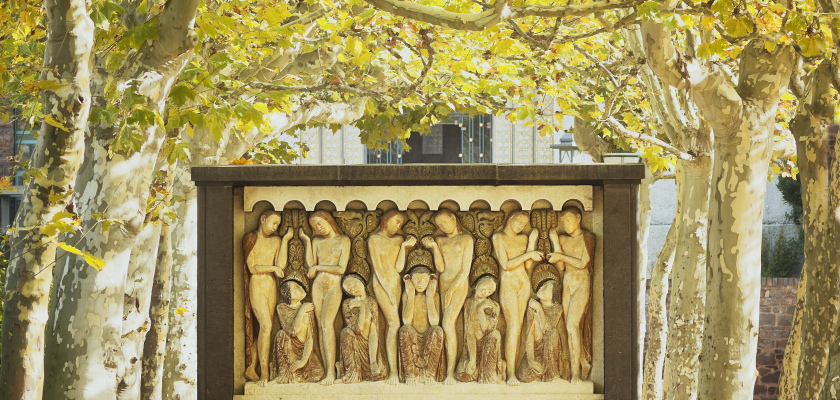
Sculpture “Dying mother with child“
The reclining figure of the dying mother is oriented towards the grove. Supported on her left arm she seems to be able to keep her upper body a little bit upright. Her head, however, is tilted backwards, which gives the dying woman an expression already removed from the world. On the mother’s lap, seemingly untouched by the dramatic events, sits the little child, lost in thought and holding a fruit in its hands.
The design for a tomb of the painter Paula Modersohn-Becker, who died young in Fischerhude in 1913, was integrated into the ensemble on Mathildenhöhe by Hoetger one year later. The individual fate of the artist is represented here as part of the becoming and passing of all life in nature.
Hoetger made sure that the structure of the stone remained visible even in the coloured areas. While the figures were painted in subdued colours, Hoetger chose a pure red for the lips and a black-grey for the hair and eyebrows and to emphasise the pupils. Some parts of the sculptures were also left uncoloured. The colours were lost early on, but the interplay of material and form is still perceptible today despite the weathered surface.
Base of the sculpture with lions
The architecture of the monument "Dying mother with child" corresponds to the tradition of Roman-antique sarcophagi. The cover is decorated with stylised clouds, the corners with acroteria in the shape of birds of prey. The slab on which the sculpture rests is supported by five stone lions. The juxtaposition of the animals also corresponds to ancient tombs.
Base of the sculpture: inscription
In the background between the lions, quotations from the early Hindu texts of the Bhagavadgita can be read as an inscription.
Hoetger designed his own typeface for the plane tree grove; the inscriptions are thus both explanatory and ornamental. This artistic means was reinforced by the originally blue background; it brings out the unity of script and artwork. The difficult-to-read typeface requires special attention, thus intensifying the perception of the ensemble with its manifold objects.
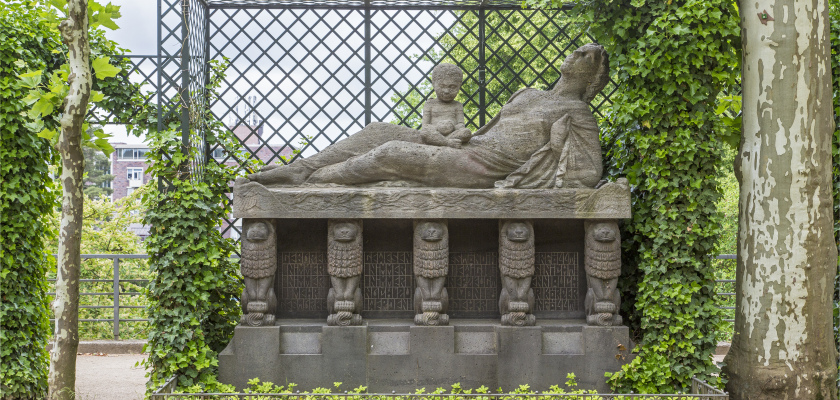
Jackal Vases
On either side of the mother-child sculpture, there are two stone vessels each, on which pairs of jackals made of cast stone rise up to the edge. With their slender bodies, protruding muzzles and pointed ears, they can be defined as desert foxes or jackals. If one associates these animal figures with the Egyptian god of death Anubis, a relationship to the monument of the dying mother can be established.
Jackal vases: bearded mask
The archaic physiognomy and block-like basic form of the bearded masks at the foot of the vases originate from the Romanesque design vocabulary. They also stand for a character that repels misfortune and can thus be seen in connection with the guardian lions of the fountain group.
Lion vases
In the south, ten stone vases carried by lions are set up as planters for agaves. The animals sitting back to back under the vases face east and west. In accordance with ancient Egyptian models, they would symbolise the eastern and western horizon and thus stand for the rising and setting of the sun. This corresponds to the bronze sculptures Day and Night of the pillars of the southern portal.
Originally, the five western planters stood elevated on a wall closing the plane tree grove to the south. Their original colouring has been almost completely lost. The ochre manes of the lions stood out against a dark blue background. The vases themselves were decorated with a blue-white-orange jagged ornament. Today the original colouring can only be seen in a few protected areas.


